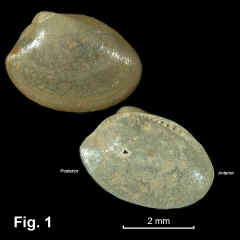|
|
NUCULIDAE |
|
|
|
Ennucula dilecta (E.A. Smith, 1891) Description: Shell average size for family. Shape equivalve, ineqilateral with umbones situated well behind midline - more so in largest specimens, weakly inflated, approximately ovate; anterior end broadly rounded; posterior end narrowly rounded to almost pointed; umbones rounded and hardly projecting. Hinge taxodont with strong teeth; up to 9 anterior and 7 posterior teeth. Chrondrophore oblique. Interior nacreous, silvery; margins not crenulate. Exterior shell surface smooth. Periostracum with concentric growth ridges, yellowish or greenish. Exterior shell colour white. Size: Lectotype 5.7 mm in length. Distribution: Known from the type lot from 750 m off Sydney, collected by the Challenger expedition, and from another lot from 27.5 miles (44 km) east of Sydney in 457-549 m. Inclusion of E. dilecta flindersi as a synonym gives a range from off Sydney, through southern Australia, to southern WA. Habitat: Known from 457-750 depth. Rare. Synonymy: The species was originally described as Nucula dilecta E.A. Smith, 1891 based on a single lot from 750 m off Sydney. Specimens later found in southern WA and SA were assigned subspecies status as Ennucula dilecta flindersi (Cotton, 1930), but according to WoRMS (2020) that is now considered as a synonym of E. dilecta. Comparison: This species is characterised by its medium size (for the family), approximately ovate shape and deep water habitat. It is considerably more elongate than E. obliqua with the umbones situated relatively further posteriorly. Fig. 1: 27.5 miles (44 km) east of Sydney Heads, in 457?549 m, dredged by SS Woy Woy, 1905 (C.024355)
|
|
